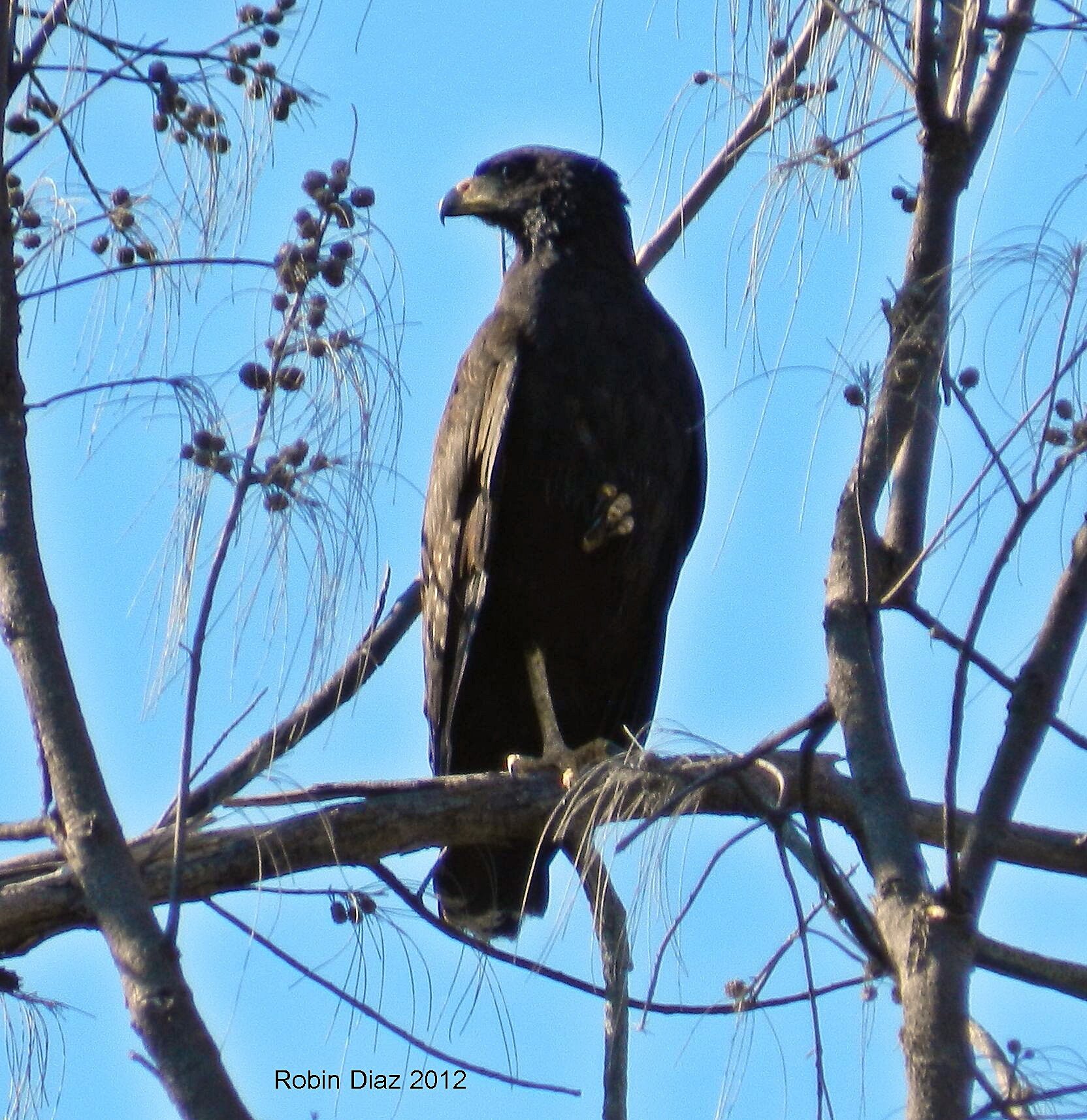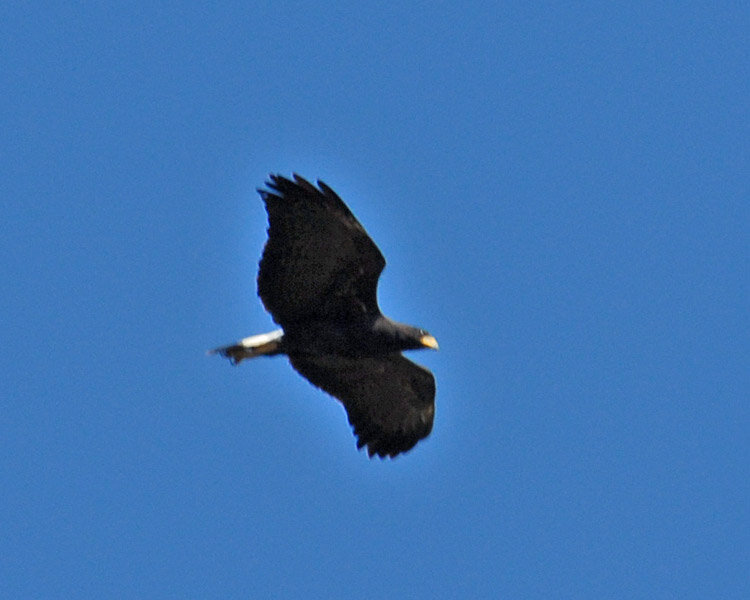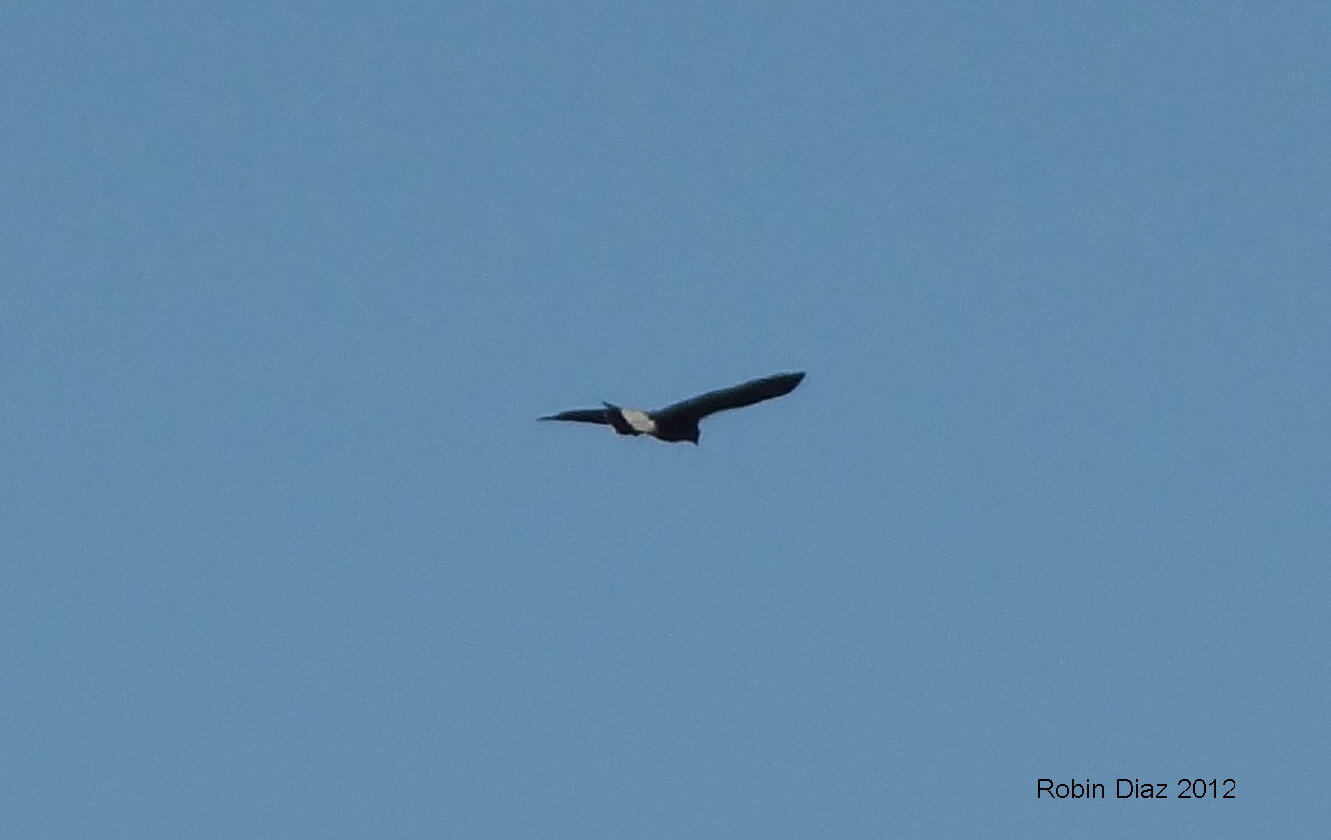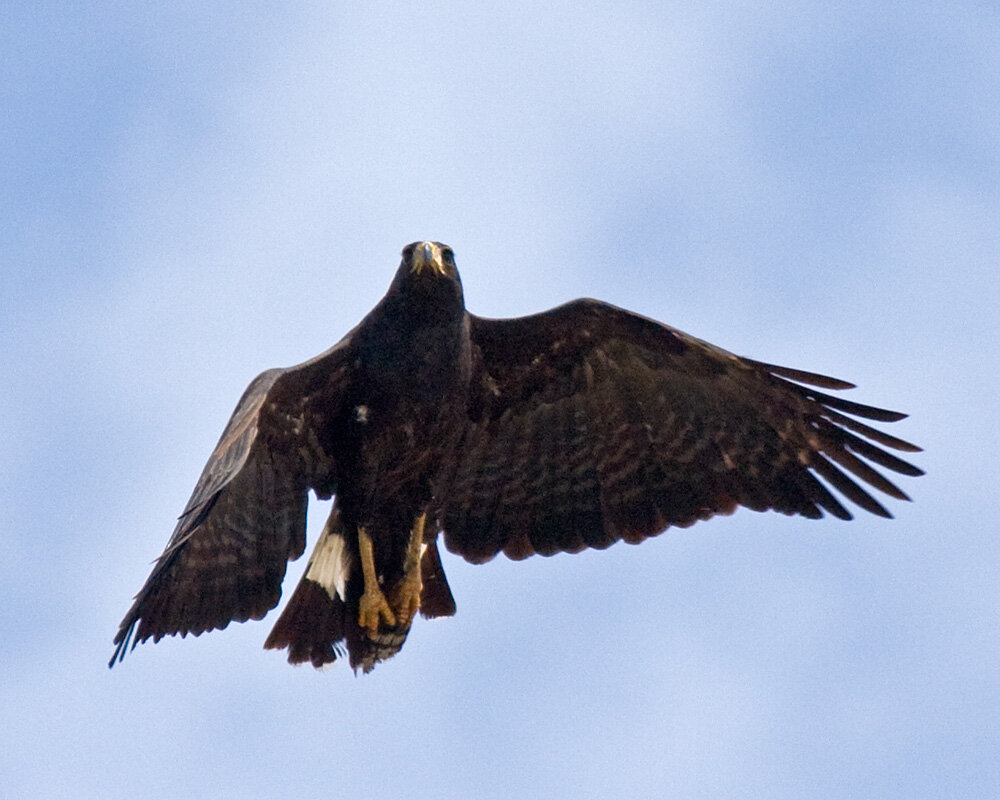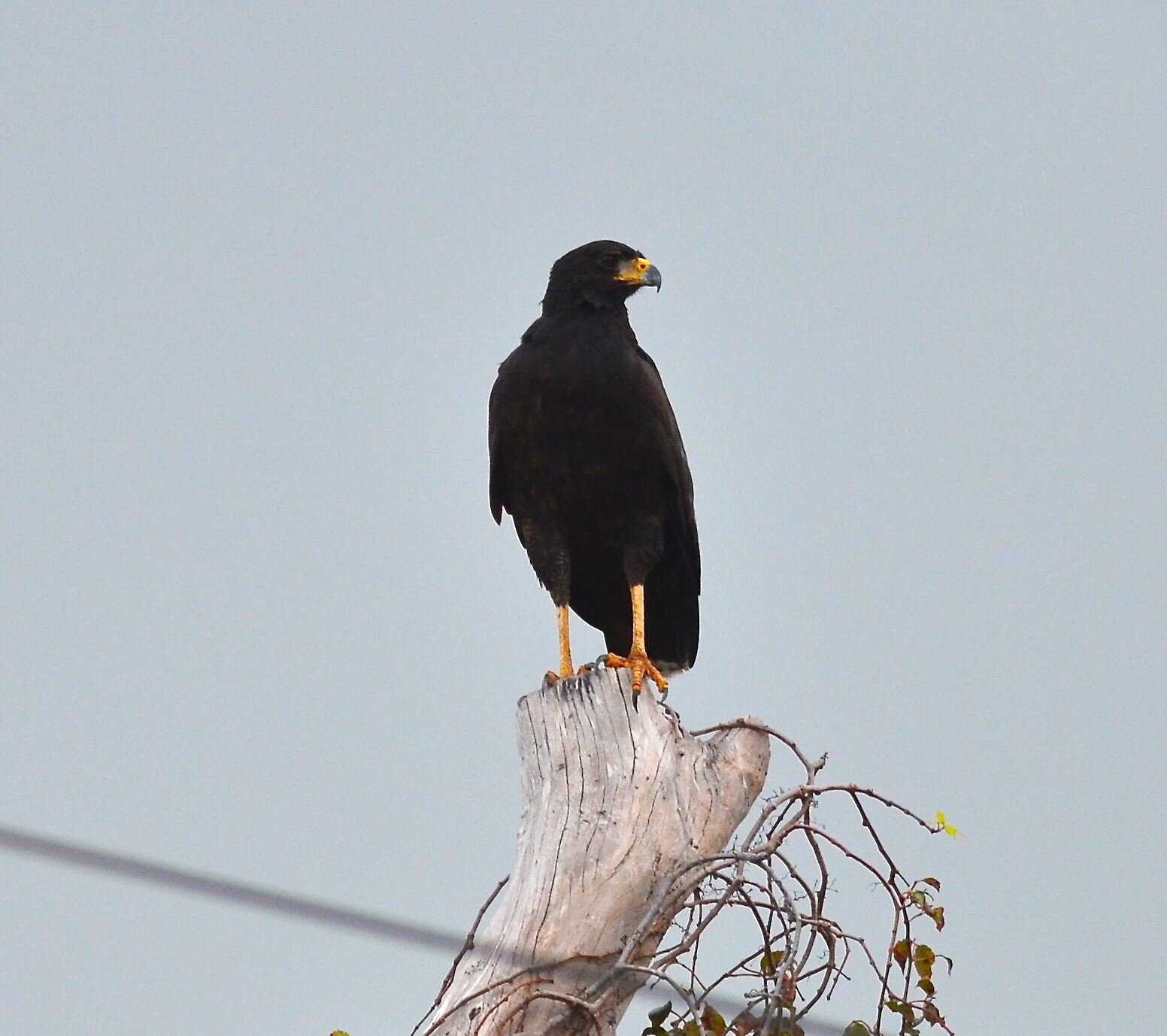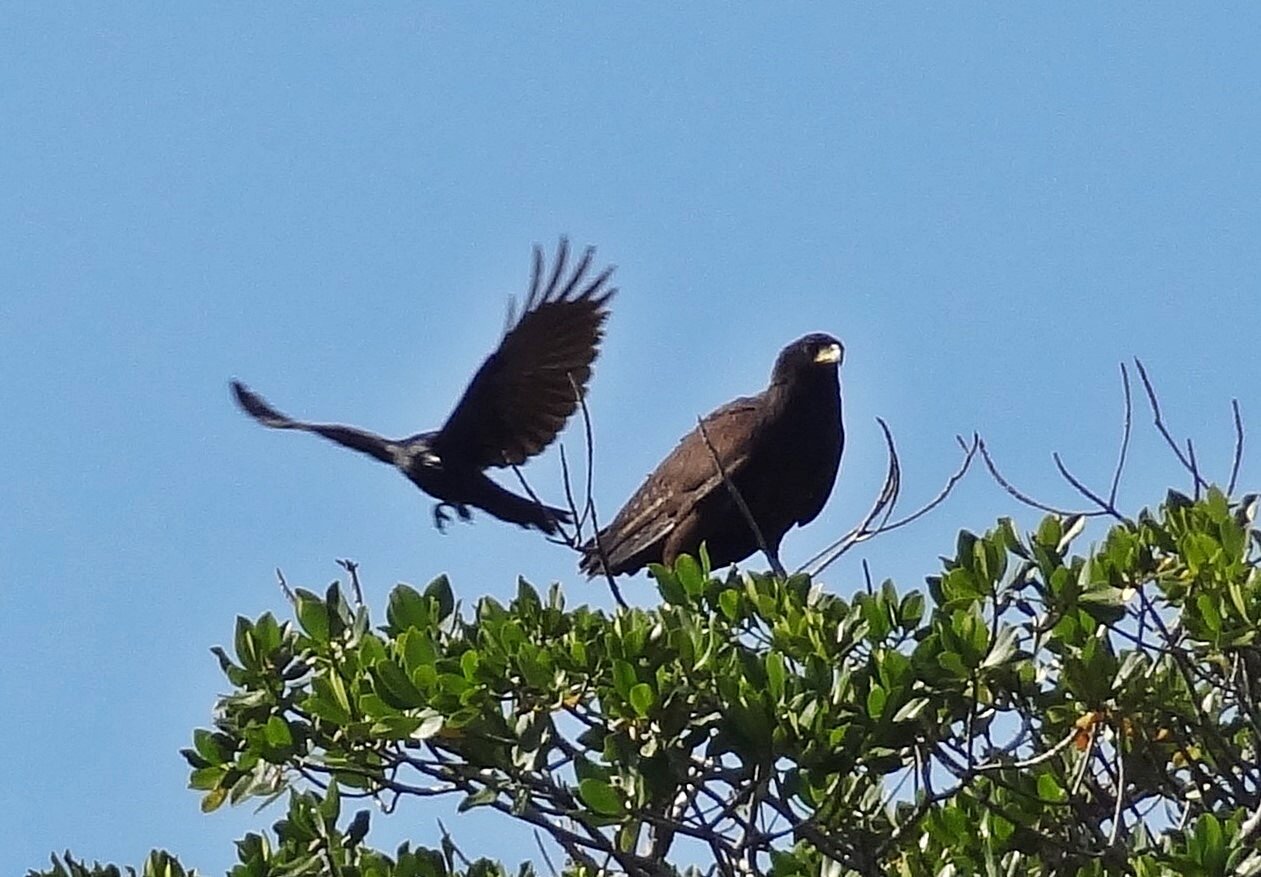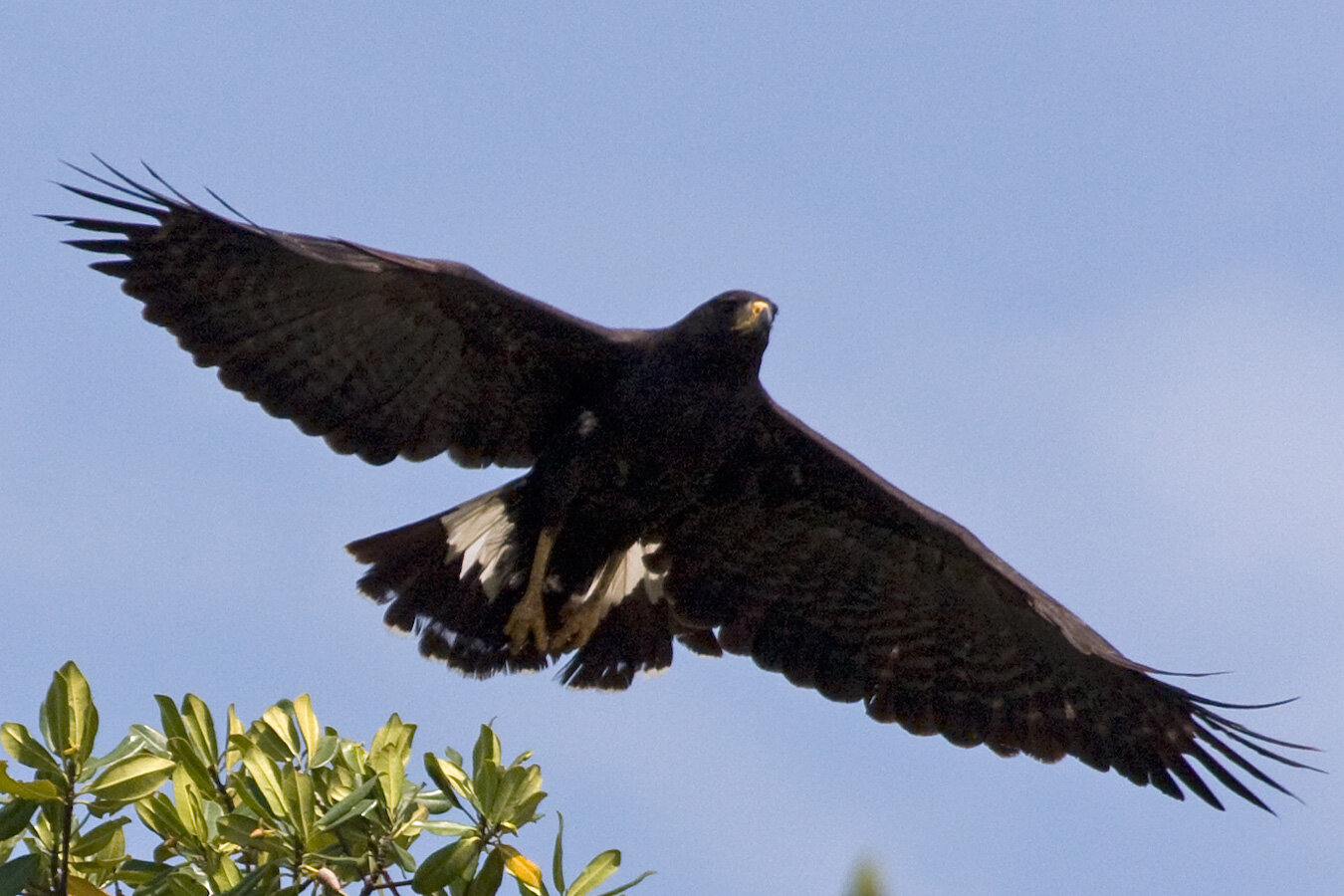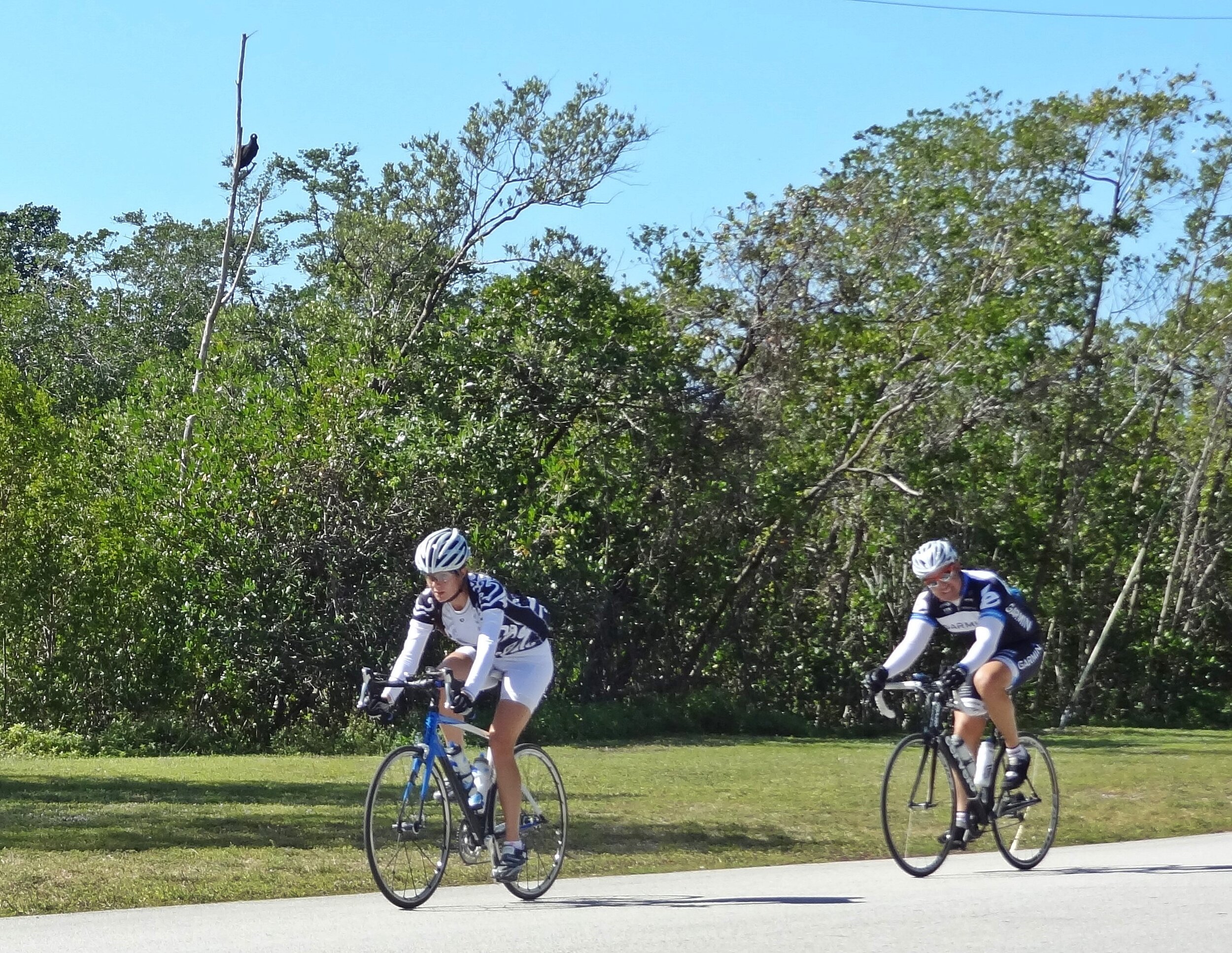Virginia Key Great Black-Hawk
by Robin M. Diaz
© 2009 by Robin M. Diaz. All rights reserved.
History
Great Black-Hawk © 2012 by Robin M. Diaz
On 12 August 1972, while birding Virginia Key, Dade County, Wally George spotted a large black hawk with white on the tail, flying at a high altitude. He alerted the birding community to the hawk's presence but not until 13 January 1973, while at the Interama Tract-Greynolds Park in north Dade County (eleven miles north of Virginia Key), did Wally get a definitive look at an adult hawk similar to the one seen five months earlier. Its tail was distinct — white, including uppertail-coverts, with the exception of a black sub-terminal band. He not only identified the bird to species, but he also determined the race: Great Black Hawk, nominate South American race (Buteogallus urubitinga urubitinga). Even though Wally nailed the identification, birds fitting his description from Virginia Key and Greynolds Park throughout the 1970's and 80's were reported as Common Black Hawks (Buteogallus anthracinus), probably of the Cuban race (gundlachii). As of 2007, this race is considered a separate species, Cuban Black Hawk (Buteogallus gundlachii). Even sightings of large dark hawks in the Keys and the Marquesas seemed to get lumped with the Virginia Key and Greynolds Park birds. Mickey Wheeler observed a similar bird 18 January 1991 and 22 June 1994 on Virginia Key and identified it as Great Black Hawk, South American subspecies. However, the adjectives “mysterious, ghostly and problematic” continued to adhere to black hawk sightings in South Florida.
Great Black Hawk in flight © 2009 by Tricia Auffhammer
Great Black Hawk departing shot showing diagnostic field marks in flight © 2011 by Robin M. Diaz
During 1973 two different pairs of adult birds were observed on Virginia Key and at Greynolds Park. Adult birds were also observed along the Dania Cut-off Canal and at West Lake mangrove area, both in Broward County. Wally observed an immature bird at the Interama Tract in the 1970's and Mark Trafton photographed an immature bird in Greynolds Park on 3 May 1975. Nick Speizio later photographed the Greynolds Park immature bird in November 1975. Thus, breeding of these black hawks in Dade and Broward Counties was presumed during the mid-to-late-1970's, although actual nesting could not be established. Christmas Bird Counts conducted in Dade County in 1974-5 and 1975-76 recorded Common Black Hawk, two in 1974-5 and one in 1975-6. Although CBC participants reported black hawk sightings a few times from the late 1970's through the 80's (M. Wheeler, pers. comm.), none of these observations made it into the historical data. Not until 2003-4, when I observed a Great Black Hawk on Virginia Key, was any other black-hawk reported on South Florida Christmas Bird Counts. A soaring bird, identifiable to species and race, was seen and reported on the following 2004-5 Virginia Key CBC.
Common Black Hawk? Cuban Black Hawk? Great Black Hawk? During the 1970's and 80's, with several possible black-hawk species to choose from, identification of sighted birds as to species was a muddy affair. Two photographs were taken of black-hawks in early 1978 and late 1979 but one bird was misidentified (Stevenson and Anderson 1994). John Ogden's summer 1975 seasonal report for the Florida region (American Birds 1975) included a note regarding the hawks seen in South Florida for the past three years. He reminded the reader “there is still not agreement that all [these hawks] are the same species...”
Great Black Hawk in flight showing white basal band © 2012 by Robin M. Diaz
Many birders suggested that if natural occurrence was to be considered, the most likely species with closest proximity to South Florida was Common Black Hawk, Cuban race (Buteogallus anthracinus gundlachii). Despite Wally George's detailed description of the bird and its identification as Great Black Hawk, South American race, subsequent sightings continued to be attributed to Common Black Hawk. Another factor contributing to the confusion is that both Great Black Hawk races, South American (Buteogallus urubitinga urubitinga) and Central American (Buteogallus urubitinga ridgwayi), are considered to be rather sedentary and unlikely to be natural vagrants. Even though many observers described the bird's tail and rump as being white with a black sub-terminal band (Wally George, pers. comm.), the identification tended to remain as Common Black Hawk. Observers also described the large hawks as black, rather than the chocolate brown of Cuban Black Hawk. In addition, no one seemed to mention a thin light malar streak or a white patch at the base of the primaries, field marks usually present on this species (Garrido and Kirkconnell 2000). From September 1972 through the 1980's, experienced birder Jim King had numerous sightings of the hawks on Virginia Key and Greynolds Park, both locations with extensive mangrove habitat. His detailed notes describe an adult on Virginia Key as “A large solid black buteo hawk (looked slightly smaller than a Red-tailed Hawk), except for broad white band on the tail extending from the base of the rump separated by black with a narrow white tail tip.” (Italics mine)
An article by Joel Abramson (American Birds 1976) perpetuated Common Black Hawk (Buteogallus anthracinus) as the identification of the Virginia Key and Greynolds Park birds. The article's title “The Black Hawk (Buteogallus anthracinus) in South Florida” is supported by the author even though the tail pattern he describes “[with] a single broad white medial tail band...” was discussed and questioned before the article was submitted (W. George, pers. comm.). The crux of Abramson's article seems to lie with the comments by Dean Amadon, Curator of Birds at the Museum of Natural History in New York City. Dr. Amadon, a noted ornithologist, reviewed a photograph of an immature hawk, taken by Mark Trafton on 3 May 1975. Although not stating unequivocally that the immature hawk was Common Black Hawk (Buteogallus anthracinus), his ending comment regarding several field marks were that “[they] seem to agree better with anthracinus.” However, his comments on the photographed bird were reserved when discussing the distinct superciliary, especially anterior to the eye. Great Black Hawk (Buteogallus urubitinga), he states, “... does in general have a much more distinct white superciliary.” Abramson also suggests that the Cuban gundlachii race of Common Black Hawk “is presumably diminishing in numbers... [and] It is conceivable that birds of this race, wandering in search of suitable habitat, could have strayed to southern Florida.”
Great Black Hawk in flight, © 2008 by John H. Boyd III
Great Black Hawk in flight, © 2008 by John H. Boyd III
Thirteen years later, authors Daniels, Hays, Morlan and Roberson discussed the 1975 photograph of the Greynolds Park immature black hawk and questioned its identification (Western Birds 1989). Their article points out that the birds described in Ogden's note (1975) lack the prominent white wing patch of Caribbean birds (Buteogallus urubitinga gundlachii). The authors also refer to Wally George's description of the tail pattern, ruling out Common Black Hawk (Buteogallus anthracinus). Regarding the South Florida bird, the authors conclude, “... the tail pattern of the immature bird shown in the published photo (Abramson 1976) suggests the bird may be a second-year Great Black Hawk.”
Other than sightings in 1991, 1994 (Mickey Wheeler) and 1995 (David Lysinger) of Great Black-Hawk on Virginia Key and a soaring bird over Matheson Hammock in 1993 (Jeff Weber, Juan Villamil), I found little evidence of reported black hawks in South Florida through the 1980's and 90's. Jim King, who observed the birds regularly on Virginia Key as well as Greynolds Park, transferred to another park in west Miami-Dade County and had no additional sightings. Until I observed and described a black hawk as a Great Black Hawk, South American race (Buteogallus urubitinga urubitinga) on 20 December 2003 during a CBC on Virginia Key, the bird(s) seemed to fade from current observations. Abby Darrah and I carefully observed a Great Black Hawk the following year, also during a Virginia Key CBC. In spring 2005 John Boyd observed a Great Black Hawk on Key Biscayne that appeared to be urubitinga race. The bird remained elusive, though seen occasionally (L. Manfredi, R. Torres, T. Mitchell, pers. comm.). The bird retained its mysterious aura until 8 January 2008 when I observed and photographed an adult.
Description
Great Black Hawk perched © 2008 by John H. Boyd III
Great Black Hawk is a large buteonine with short broad wings, short tail and long legs. The adult (sexes similar) is black, while the juvenile is streaky brownish. It seems to have a sluggish, labored wing beat and is comfortable walking on the ground. Habitats for this bird are varied, and the South Florida birds were (are) are usually seen near coastal mangroves.
There are two races or geographical variations:
Great Black Hawk perched © 2012 by Giovanni Para
Buteogallus urubitinga urubitinga (South American, Southern, Eastern, nominate race) is slightly longer-winged than the Central American race. The lores are yellow (or bleeds yellow, as with the Virginia Key bird), the uppertail-coverts and whole basal half of the tail are white. The tail is sometimes described as white with a wide black sub-terminal band. A diagnostic field mark is that the feathered “thigh” is plain black. While this race is described as having plain black wing-linings, I found that there is subtle black-on-black patterning on the wings of the Virginia Key bird. The tail pattern and the lores of the Virginia Key bird fit this race, as well as the lack of “thigh” barring. The Virginia Key bird also shows a narrow white terminal tail band. These field marks have been observed, noted and photographed during my many observations of this hawk in 2008.
Buteogallus urubitinga ridgwayi (Central American, Mexican, Northern, Western) has slate-colored lores with wing-linings and “thighs” marked with fine white spots or barring. The tail has white uppertail-coverts but it is inconspicuous and separated from a broad median tail-band.
Descriptions from my notes include various sightings: large, black hawk perched; short tail with narrow white terminal band; bright yellow cere and light yellow legs; white tail patch obvious (especially flying) that seemed to extend up to rump area; broad wings obvious when flying; apparent very long legs; subtle light and dark pattern noted on wings; lores seen well — yellow bleeding into loral area; white uppertail-coverts seen well when bird perched facing away.
After observing the Virginia Key black hawk from 2003-2008, I eliminated the following birds as possibilities:
Great Black Hawk, Central American race (Buteogallus urubitinga ridgwayi): This bird's tail pattern does not include a large white basal area of the tail; its lores are dark, sometimes described as slate; white barring on the “thighs” is diagnostic; the wing-linings usually have white spotting.
Cuban Black Hawk (Buteogallus gundlachii): This bird is dark chocolate brown, not black; it has a white patch at the base of the primaries that is easily seen when in flight; its tail pattern includes one white median band and narrow inconspicuous uppertail coverts; usually, a thin white malar streak is visible; its vocalization is a unique “ba-tis-ta” call.
Common Black Hawk (Buteogallus anthracinus): This is a smaller black-hawk with shorter legs; it has a white patch at the base of the primaries that is easily seen in flight; its tail pattern includes one white median band and narrow white tail tip but it lacks white uppertail-coverts.
Vocalization
Great Black Hawk calling © 2008 by Robin M. Diaz
Great Black Hawk giving staccato call © 2011 by Robin M. Diaz
When the Great Black Hawk is present, it is usually noisy. I observed the bird only one time calling in flight. When perched, it seems to have three distinct vocalizations: 1) 5-7 loud, quick, even pitched “kee” calls, slightly faster than an Osprey; 2) weak, high-pitched, descending plaintive whine; and 3) loud staccato call lasting 6-7 seconds, slightly ascending, then descending. I observed the hawk on the ground one time for 10 minutes and during this span it gave all three calls, albeit shorter and softer versions than when the bird is perched. Of the two Great Black Hawk recordings I have, “Birds of Southwest Ecuador” (John V. Moore, Nature Recordings) is a good match. The calls on “Voice of Costa Rican Birds” (David Ross and Bret Whitney) are unlike those I hear from the Virginia Key bird. I am unable to establish a relationship between the bird's behavior and its different calls. However, it seems to give the staccato “kee” calls immediately after landing on a high perch and does not call with plaintive whine until it has settled for a few minutes.
Behavior
Great Black Hawk perched, harassed by Fish Crow © 2012 by Robin M. Diaz
Great Black Hawk in flight © 2009 by Tricia Auffhammer
My Virginia Key observations to date are of a solitary bird. It is either perched, coming up off the ground or flying to or from the immediate area. A 10-minute observation 4 August 2008 was the only time I saw it remain on the ground. This was also my only observation of the bird eating, although distance prohibited me from identifying the food source. Four Black-necked Stilts were nearby, calling but not flying around the hawk. Other waders (Reddish Egret, Great Egret, Tricolored Heron, Snowy Egret) were within a 30-yard range and seemed unperturbed by the hawk's presence. I have seen no evidence of courtship display or nesting behavior. I only observed the bird soaring once, 18 December 2004. Interaction with other birds has been noted: 1) harassed by American Kestrel while perched 20 December 2003; 2) following (chasing?) a Red-shouldered Hawk for approximately 50 yards on 29 January 2008; 3) being harassed by Black-necked Stilt parents on 29 June 2008; and 4) on 7 August 2008 it seemed to respond with its plaintive whine to a calling Red-shouldered Hawk, then flew to the area and immediately flew back to mature mangrove stand where it continued to respond to calling Red-shouldered Hawk; when the Red-shouldered stopped calling, the Great BlackHawk called fewer times, with more pauses between vocalizations.
Recent Sightings
Between the reported CBC sightings of 2003-4 and 2004-5 and the current 2008 sightings, I have seen a Great Black Hawk on Virginia Key only one other time. The bird perched briefly along Crandon Boulevard on 10 December 2006. This is the western border of Bear Cut Preserve, a dense coastal mangrove area less than a quarter of a mile from Virginia Key. Other than one sighting in the coastal dunes, the bird is consistently seen near or in mature mangroves. While doing a preliminary survey of Virginia Key restored areas on 8 January 2008, I observed and photographed a perched Great Black Hawk. After it flew, I relocated it and at that time, I saw the tail pattern well and concluded that it was the nominate race of Great Black Hawk (Buteogallus urubitinga urubitinga). Between 8 January and 4 August 2008, the Virginia Key bird has been observed and photographed 20 times, to my knowledge.
Great Black Hawk in flight © 2008 by John H. Boyd III
The sighting dates and observers' names are:
8 January: Robin Diaz
Great Black Hawk perched in Casuarina © 2010 by Robin M. Diaz
29 January: Robin Diaz, Jean Aldrich, Joan Renniger
3 February: Tricia Auffhammer, Bonnie Ponwith
1 March: Robin Diaz
3 March: Robin Diaz, Liz Golden, Gary Milano
4 March: Robin Diaz
18 March: Robin Diaz
22 March: Robin Diaz
26 March: Robin Diaz
30 March: Robin Diaz
1 April: Gary Milano
2 April: Robin Diaz
5 April: Robin Diaz, John Boyd, Joel Rosenthal
29 June: Kathy Burkhart
24 July: Bonnie Ponwith
25 July: Bonnie Ponwith
4 August: Robin Diaz
7 August: Robin Diaz
9 August: Carl Edwards
10 August: Robin Diaz
Habitat
The habitat is restored wetlands, mature mangroves and mixed secondary growth with scattered dead Casuarinas.
Provenance
Great Black Hawk calling © 2009 by Tricia Auffhammer
The provenance of Great BlackHawks seen in South Florida during the past thirty-six years has been examined and frequently picked apart by ornithologists and birders. In examining notes and observations from the 1970's and 80's, it now appears that Great Black Hawk (Buteogallus urubitinga urubitinga), rather than Cuban Black Hawk (Buteogallus gundlachii), was the species seen on Virginia Key as well as Greynolds-Interama. Knowing what is here does not answer the question of “How?” Since the South American race of Great Black Hawk is more-or-less sedentary and is the farthest from Florida of the black-hawk species, natural agency seems a big stretch as a means for the birds' presence. Rumors persisted for years that the hawks were escaped birds from Crandon Park Zoo, then later, Miami Metrozoo. Jim Dunster of Miami Metrozoo checked records for both locations and reported that Great Black Hawks were never displayed at either zoo or gardens (E. Alvear, pers. comm.). The time span of thirty-six years adds an interesting facet, as it is improbable for a single buteo-like bird to survive in the wild for this length of time.
In 1995 P. William Smith, one of the most experienced observers of exotic birds in South Florida, expressed an opinion that the Great Black Hawks reported from this area throughout the years were escaped from captivity, whether accidental or deliberate releases (M. Wheeler, pers. comm.). I wonder if a misguided falconer from the 1970's released his bird from duty, after time and again, the hawk returned with its preferred prey, a land crab. Indeed, Great Black Hawk is considered a part of Florida's exotic avifauna (Pranty 2004) and a bird to which the Migratory Bird Treaty Act does not apply (Trapp 2005). While there has been no proof of nesting, they may have experienced very limited breeding. We continue to use “mysterious” when describing its origins; meanwhile, we enjoy its exciting and majestic presence.
Addendum
From 2009 through 2015, the Virginia Key Great Black Hawk was seen and photographed periodically, including during Christmas Bird Counts. My personal sightings included approximately ten times a year, but rarely during summer months. Its behavior remained consistent with previous observations but if Fish Crows were nearby, they would mob the hawk. Blue Jays also disliked its presence. It did not seem skittish and allowed fairly close observations. I last saw this Great Black Hawk in November 2015 but when birders visit Virginia Key, we all continue to search and to hope for another sighting of this exciting and majestic bird.
In 2014 the AOU North American Classification Committee (NACC) removed the hyphen from the names of three Black Hawk species, including Great Black Hawk. It was determined that the three species (Common Black Hawk, Cuban Black Hawk, Great Black Hawk) are not closely related and therefore, should not share the same “last name.”
Great Black Hawk next to road © 2012 by Robin M. Diaz
Acknowledgements
I wish to express my sincere thanks and appreciation to Wally George for his continued encouragement and generosity with his notes and records, to Mickey Wheeler for her notes and helpful comments on the narrative, to Jim King for his detailed notes and observations, to Fred Lohrer for his research help and to Tricia Auffhammer, Bonnie Ponwith and John Boyd III for their gracious generosity in sharing their photographs.
Literature Cited
Abramson, I. J. (1976), The Black Hawk (Buteogallus anthracinus) in South Florida, American Birds 30, 661-662.
Daniels, B. E., and L. and D. Hays, and J. Morlan, and D. Roberson (1989), First record of the Common Black-Hawk for California, Western Birds 20, 11-18.
Ferguson-Lees, J., and Christie, D. A. (2001) “Raptors of the world”, Houghton Mifflin, Boston, MA.
Garrido, O. H., and A. Kirkconnell (2000), “Field guide to the birds of Cuba”, Comstock Publishing Associates, Ithaca, NY.
Ogden, J. C. (1975), The nesting season: Florida region [Summer 1975 report], American Birds 29, 960-963.
Pranty, B. (2004), Florida's exotic avifauna: a preliminary checklist, Birding 36, 362-372.
Ridgely, R. S., and J. A. Gwynne, Jr. (1989), “A guide to the birds of Panama”, Princeton University Press, Princeton, NJ.
Robertson, W. B., Jr., and G. E. Woolfenden (1992), “Florida bird species: an annotated list”, Florida Ornithological Society Special Publication No. 6, Gainesville, FL.
Stevenson, H. M., and B. H. Anderson (1994), “The birdlife of Florida”, University Press of Florida, Gainesville, FL.
Trapp, J. L., (2005), Documenting the Occurrence of Human-Introduced Bird Species of Non-Native Origin in the United States and its Territories United States Fish and Wildlife Service.
© 2009 by Robin M. Diaz. All rights reserved.

